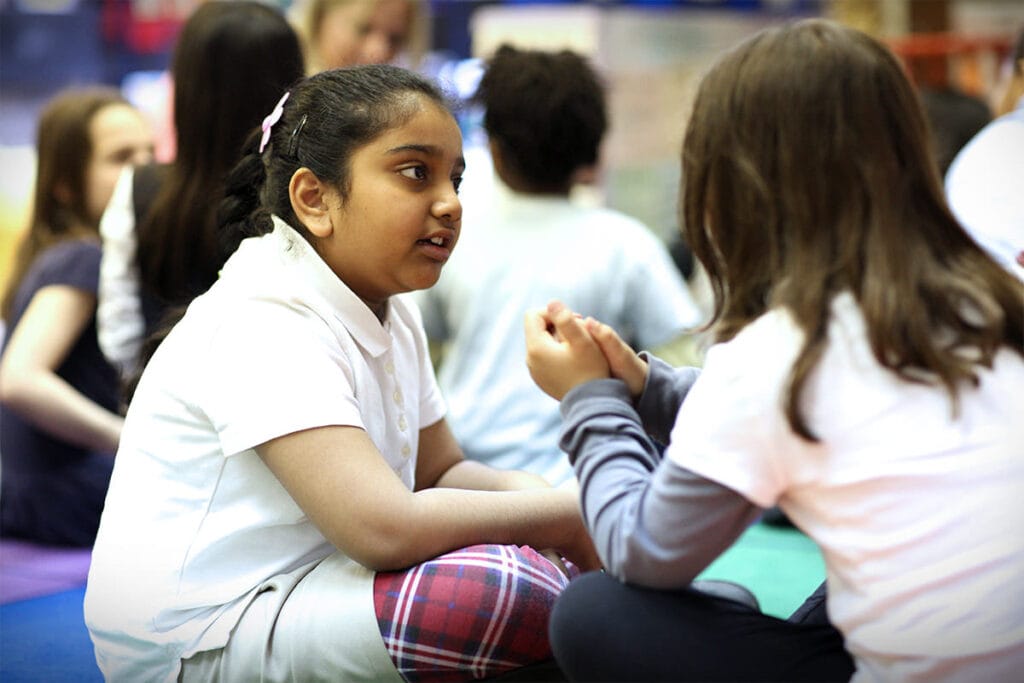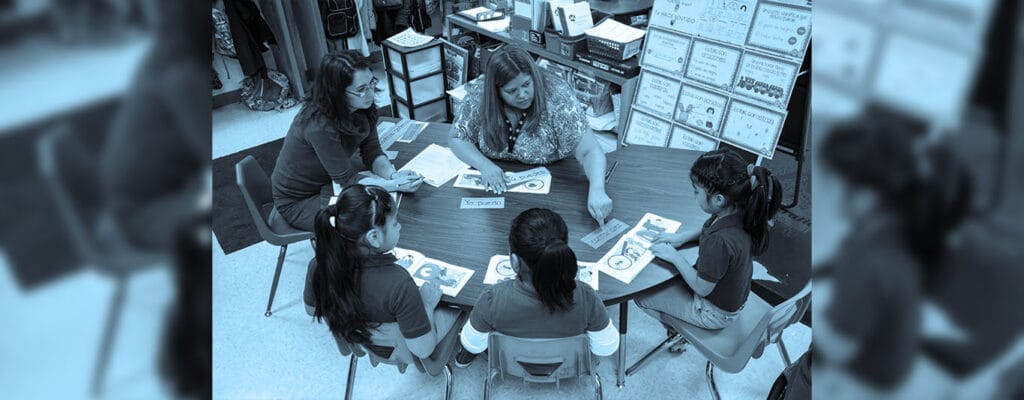


Turn and Talk, in which children are partnered up to take turns listening and speaking with one another, is a common classroom practice with many benefits. It allows all children to share their thinking with one another, it helps children develop their oral language skills and the pragmatics, or social conventions, of discourse. Turn and Talk also provides teachers with an excellent opportunity to be intentional and explicit about teaching and scaffolding, speaking and listening behaviors. As children internalize the procedures around Turn and Talk, you can use this tool to develop children’s growing oral language development over time.
Here are several ways to scaffold children’s conversations so that they become increasingly multifaceted.
When you are first establishing the procedure of Turn and Talk, children might practice the procedure with short, simple answers. For example, you might prompt a closed question, such as “What is your favorite food?” Once the partners are sitting knee to knee and eye to eye, the first speaker (with hands on top) might simply say to her partner “pizza,” and when the children switch turns/hands, the second child (now with hands on top) says, “cereal.” At this beginning part of the progression, we are ensuring that the procedure is in place and really setting the stage for powerful talk and more oral language development opportunities to occur in the future.
Once you determine that the procedure is truly a consistent routine, children are easily and smoothly transitioning in and out of Turn and Talk, facing their partners, making eye contact, and taking turns. Through thoughtful scaffolding, you can now help children to articulate their answers. For example, perhaps you still pose a closed question, like “What is your favorite animal?” but now you offer a sentence stem to structure their responses into a complete sentence. As an additional language support, you can have the sentence stem written on a sentence strip and model explicitly using it to guide your own response (i.e. “My favorite animal is a giraffe. I am using this sentence starter to share my thought: My favorite animal is ___. When you share with your partner please also use this stem to start your sentence: My favorite animal is ____”).
Another useful scaffold to help children further develop their expressive language is to build in a stem that requires a longer, more thoughtful talking point. To continue with the previous example, “What is your favorite color, and what is something that is that color?” Now you may also add on to the previous sentence stem idea: “My favorite color is ___. A ___ is ___.” So now you can model and guide the children in adding on (i.e. “My favorite color is purple. A grape is purple”).
We certainly are not limited to closed questions during Turn and Talk. Rather, as in our first strategy of asking curious questions, we want to ask children open questions to really draw out their thoughts and feelings and encourage them to talk more. This can be especially poignant when you incorporate Turn and Talk into a lesson such an an Intentional Read Aloud. For example, suppose you are reading the book Swim, Duck, Swim (included in the Blueprint for Early Literacy PreK Curriculum) and working on the comprehension strategy of making predictions. You might pause to model making a prediction using the sentence stem “I predict…” and then a few pages later you can have the children turn and talk about their predictions using the same sentence stem “I predict.” Surely, there is no one correct answer here, and an open question allows the children to express their unique thoughts and feelings. Depending on what is developmentally appropriate, you can even offer them a way to add on to their responses. You also can teach into partnerships, offering differentiated scaffolding to the children while they are doing turn and talk.
As the children progress, we want to scaffold a true back-and-forth conversation where they can elaborate on their ideas and others’ ideas with their peers. So if the children are discussing their predictions in Swim, Duck, Swim, they might talk about the character or the setting as it relates to the prediction, they may reference a real life connection or even another familiar book. Perhaps something that the first child says sparks an idea that the second child can piggy back off of. Maybe children can have different ideas and still respectfully disagree as they listen to one another. (Certainly in Pre-K, this more sophisticated level of turn and talk would require a bit more teacher scaffolding to help guide and shape a relevant and productive conversation between children.)
As a deeper expression of whole-body listening that we would teach at the procedural level, we can hold children accountable for not only sharing their own thoughts and feelings through scaffolded expressive language opportunities, but also for practicing active listening. That is, hold children responsible for actively listening to what their partner says. One way you can do this is by asking a child to tell you or share with the class something that her partner said, rather than repeating what she herself said. This still allows the child to practice using expressive language during Turn and Talk, now with the added layer of being an accountable active listener to her friend.
Turn and Talk is clearly a strategy that can be used throughout the year with all children. It can be an instrumental tool for promoting oral language development for your children.
Written by Erin Zuccaro & Michele Coulombe.


Job-embedded coaching is the key to teacher retention and literacy success. By providing real-time support, fostering collaboration, and improving instruction, coaching helps educators thrive[..]

CLI’s 15 on Friday podcast delivers bite-sized conversations on literacy and equity in just 15 minutes. Featuring authors, educators, and advocates, each episode inspires[..]